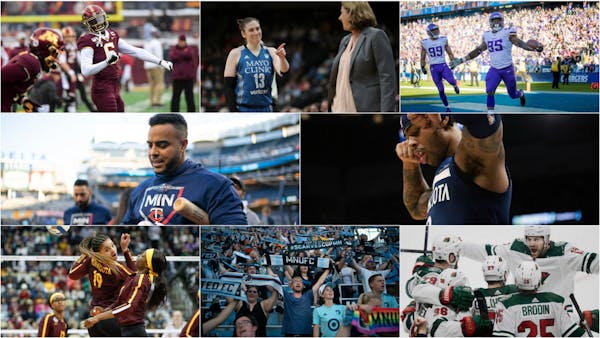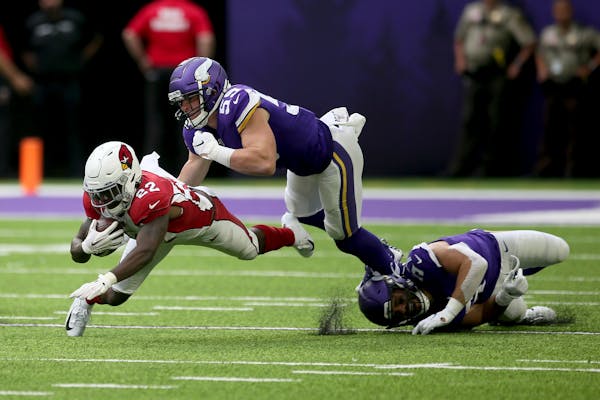Before Eric Kendricks begins his football routine, the Vikings' Pro Bowl linebacker must prepare for the coronavirus.
"You used to check phone, keys, wallet," Kendricks said. "Now it's phone, keys, wallet, mask, proximity locator."
Every morning at TCO Performance Center this season, an innovative proximity device is assigned to players, coaches and staffers to help prevent a COVID-19 outbreak and enforce social distancing. The SafeTag sensors, worn as a wristband, badge or in jerseys, record distance between devices and time in close contact. They flash or sound an alarm if a personal bubble is breached. If someone tests positive for the coronavirus, the data helps immediately quarantine those recently in close contact.
Kendricks, among prominent NFL players who called for the league to improve safety protocols before reporting to camp, said the devices are a worthwhile layer of security.
"They explained to us the reason behind it," Kendricks said. "Those devices will allow us to quarantine effectively. So, there is a reason behind the madness and we're all going to do it. It's going to take all of us, and we're going to do our part and get this thing rolling."
Cases are inevitable, league doctors admit, but the goal is to limit outbreaks like the one that halted the Miami Marlins' baseball restart when 18 players tested positive. Medical experts praise the NFL's rigorous contact tracing, but question the viability of a full season and its demand on testing infrastructure while COVID-19 continues to spread in communities.
"It's so difficult because there's so much asymptomatic transmission and false negative results," said Ryan Demmer, an associate professor of epidemiology and community health at the University of Minnesota. "The NFL is trying to keep people physically distant in facilities with these devices, that helps, but it's hard to see that actually working. You're thinking about men in their 20s playing a sport that's all about physical contact."
Tracking interactions
Football and social distancing do not mix. So, the NFL was a quick buyer when an existing partner — Kinexon, a German company with U.S. headquarters in Chicago — wanted to tweak its performance tracking technology used by NFL and NBA teams into contact tracing hardware.
Mehdi Bentanfous, Kinexon's CEO of North America, said a ultra-wideband radio frequency that tracked metrics like distance, acceleration and speed was converted to design the NFL's system of a reported 10,000 SafeTags. The NBA is using the same system inside its Florida bubble.
The tags are required inside all team facilities, on the practice field and during team travel, but they do not record location or GPS data, according to Bentanfous. A person's daily contacts are anonymized, with tag assignments only available to a handful of people on each team.
If someone tests positive, a third-party company — IQVIA — will "within minutes" generate a report of contacts who may need to take precautions, according to the Vikings' infection control officer and top trainer Eric Sugarman. (He tested positive for the virus last month before players were allowed inside facilities.)
Sensors help separate NFL employees into three tiers, divided by how close they need to be to players, who are in Tier 1. The tag's alarm sounds when a Tier 3 person gets too close to a Tier 1 or Tier 2 member, or if anyone enters a restricted area.
Within tiers, tags can be adjusted to flash red inside 6 feet of each other and a timer counts down — reminding the wearer that 10 such minutes in a day is deemed "close contact," which necessitates quarantine if near an infected person.
Per NFL protocols, close contact also includes living in the same house, direct contact or sharing an object during practice, or handling the equipment of another person.
"Every time someone comes close to me," General Manager Rick Spielman said, "my little buzzer starts beeping and it says I have a minuteand a half wasted with you and I have eight-and-a-half minutes left."
Adjusting behavior
Because the NFL opted against a bubble, responsibility shifted to the players to avoid infection away from work. The wristbands can help alter behavior within teams, but players leave the facility — and their sensors — at the end of the day.
"High-risk conduct," which includes attending an indoor bar with more than 10 people, can lead to fines from the team and league. Head coach Mike Zimmer said making wise choices is a topic at almost every Vikings meeting.
"It's going to be even more challenging as the season goes on, and there's a little bit more free time," right tackle Brian O'Neill said. "We talk about it, but really, all you can control is yourself. There's a lot of responsibility to my teammates and to the families of my teammates."
Outbreaks like those on MLB's Marlins and Cardinals, which infected at least 26 players and postponed more than 20 games, would be considered the "best-case scenario" for the NFL, which has more players and closer contact, according to Dr. Zach Binney, epidemiologist at Oxford College of Emory University. Not sequestering teams in a bubble is "a gamble," he said.
"I'm also unclear on how much risky behavior had anything to do with what happened in MLB," he added. "We don't know what the driving force was behind these outbreaks."
The NFL has not publicized a plan if an outbreak spreads through a team. Dr. Allen Sills, the NFL's chief medical officer, said the league's plans were evolving and "all options remain on the table" when asked by NFL Media last week about moving to regional bubbles.
"We expect our protocols to change," Sills said on NFL Network. "They're going to adapt as we do learn new things throughout the course of the season."
A tall order
Possibly hundreds of thousands of tests may be required to fulfill NFL protocols for the duration of a season, concerning experts amid nationwide backlogs and long wait times. The league said it has conducted 75,000 tests so far; according to the COVID Tracking Project, about 750,000 people are tested daily.
"Given we don't have good answers for where the supply chain issues are and how professional sports testing is going to intersect with it," said Demmer, the U of M epidemiologist, "I'm starting to get fairly concerned about doing it."
The NFL hired BioReference Laboratories, a private company that is also working with the NBA, WNBA, and MLS, to test and process results with a 24-hour turnaround. Immediate results are key to the NFL's contact tracing efforts. The public average wait is four days, according to a July study surveying 19,000 Americans representing every state.
The league's testing schedule will move from daily to every other day if the positive rate is below 5% after the first two weeks. That schedule and proximity tags that guide even more testing are the lengths the NFL and NFLPA currently require to shield teams and the season.
"You could bring something into the building that could destroy a position group, or a group of coaches," tight end Kyle Rudolph said, "and it's something that all 32 teams will have to be conscious of."
Sign of the times: NCAA approves coach-to-player helmet communication for 2024 football season
John Hynes of Minnesota Wild to coach U.S. men's national team at world championships in Czechia


